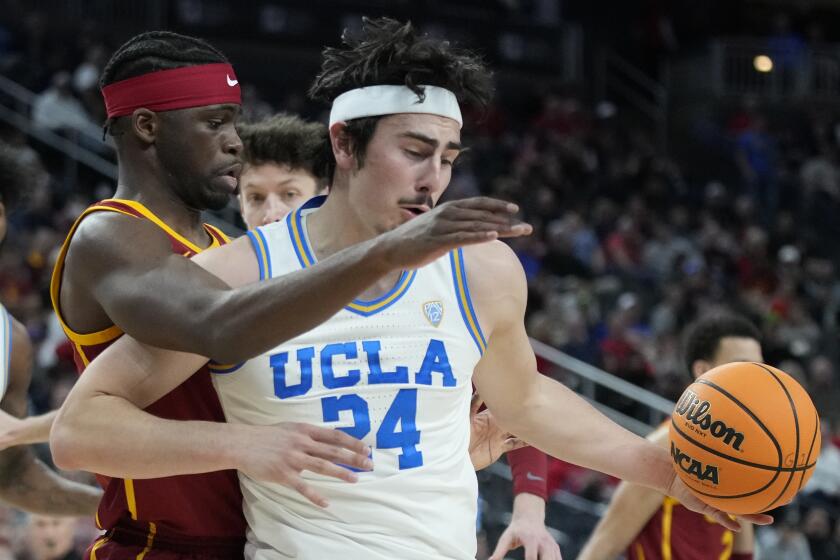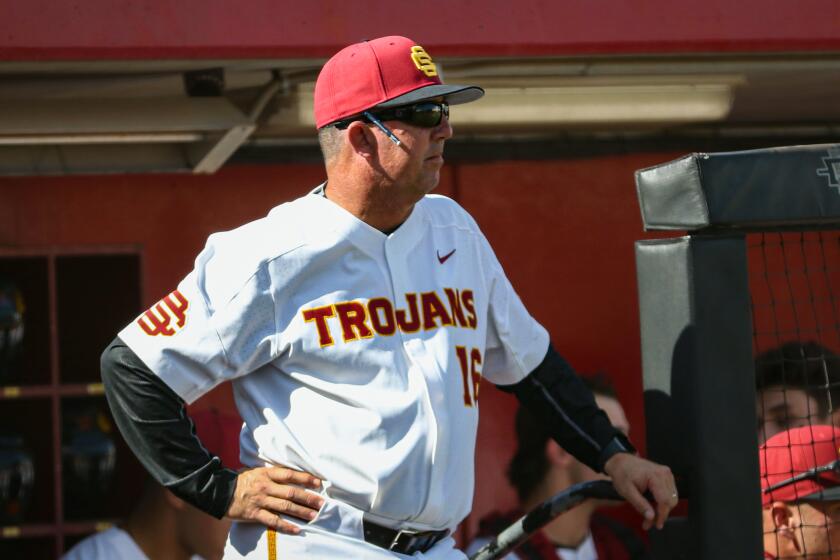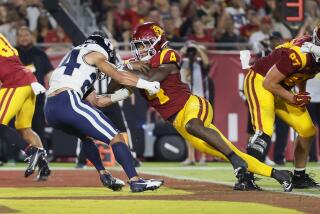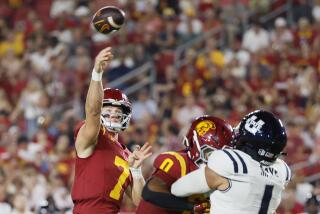Boogie Ellis can’t be expected to carry the USC offense in the NCAA tournament
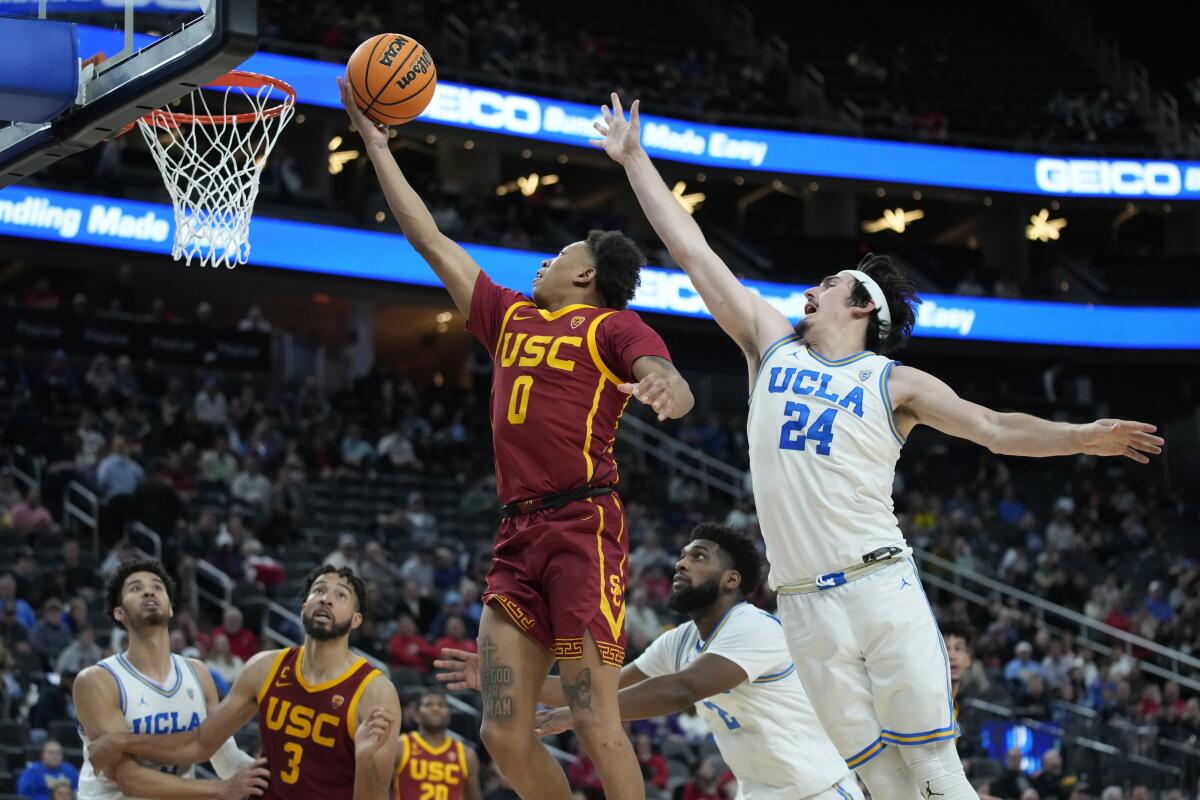
- Share via
This time, there would be no escape.
As the crosstown rivals met for their rubber match, the cold realities of March offered a stern reminder to USC. Slip up once, and your record-breaking season soon could be over.
UCLA got the better of USC in their third meeting Friday, and as both enter March Madness with their eyes on another deep run, it’s the Trojans who have the most questions hanging over them.
Here’s what we learned after USC’s 69-59 loss to UCLA:
USC has no worries on Selection Sunday. But after that …
The Trojans might be comfortably in the field, but nothing about the last two weeks should leave them feeling comfortable heading into the NCAA tournament.
Jaime Jaquez Jr. and second-seeded UCLA beat third-seeded USC 69-59 in the Pac-12 tournament to advance to Saturday’s final versus top-seeded Arizona.
The Trojans might be comfortably in the field, but nothing about the last two weeks should leave them feeling comfortable heading into the NCAA tournament.
The offense has been stagnant. USC’s top scorers have been inconsistent. And the defense hasn’t been enough to overcome either problem. Even when the Trojans have won over the last month, they’ve done so by the skin of their teeth, escaping in the final minutes.
That strategy isn’t usually a successful one this time of year. All it takes is one slip-up for USC to be sent packing, and the Trojans have been particularly prone to those types of problems lately.
Fortunately for USC, its invite isn’t incumbent on its performance the last two weeks. The Trojans still won 25 games in the regular season, a school record. That counts for something.
Most bracket projections have USC in the range of a six or a seven seed. UCLA coach Mick Cronin called that likely seeding “ridiculously low” and attributed it to “West Coast bias.” But the truth is USC is nowhere near peaking at the most important point of its season. Unless it can turn things around, it could be headed for an early exit.
UCLA had better defense, rattling USC inside
All season, USC has hung its hat on defense. Its interior work was especially strong given its extraordinary size and length. Inside the arc, few defenses in college basketball have been better this season.
But Friday night, it was UCLA that made its presence known around the paint. Bruins big man Myles Johnson helped shut down USC on the interior, leaving Isaiah Mobley unable to make much of an impact around the basket. Mobley finished with just nine points, while fellow forward Chevez Goodwin was even less of a factor, finishing with five on two-for-seven shooting.
USC made just four of 17 shots inside the arc during the first half on its way to 28 points. Without a consistent presence inside, the Trojans were left scrambling, settling for perimeter shots as their offense struggled to settle into a rhythm.
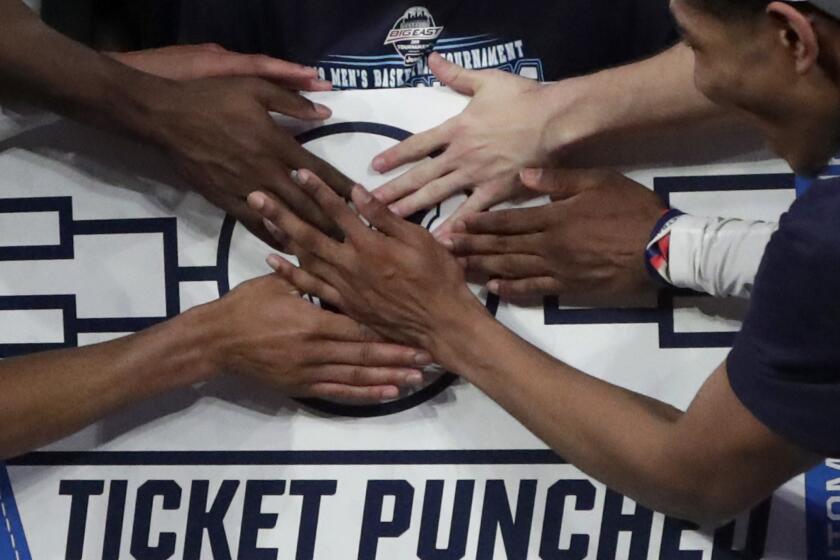
NCAA basketball bracket: What time is Selection Sunday? How to stream and watch
Selection Sunday is almost here. It’s time to find out which college basketball teams will be engaging in March Madness and playing in the NCAA tournament.
Coach Andy Enfield saw no reason for concern.
“We just have to finish some of those,” he said. “It’s nothing they did.”
But what was once a clear advantage for USC certainly no longer seems that way.
USC limited its turnovers but offense still struggled
Sure, it’s not hard to improve on 23 turnovers. But USC’s nine giveaways Friday night actually ranked among its lowest totals of the season.
That was the good news. The problem is it didn’t matter much. USC still struggled to move the ball and often found itself relying on Boogie Ellis to make plays in isolation. The crafty ball movement that USC has flashed at its best was nowhere to be found. The Trojans finished with a meager six assists, their fewest of the season.
“We need a higher assist total for us to reach our potential offensively,” Enfield said. “We just need to be more efficient.”
USC baseball was once the NCAA’s gold standard. Jason Gill, the latest coach to try to resurrect it, has faced challenges, many of them his own making.
Where that efficiency might come from is a legitimate question. Ellis isn’t exactly a floor general, and neither Drew Peterson nor Mobley has proven himself as an entirely capable catalyst. USC may have to figure it out on the fly as it continues to question who should initiate the offense.
Ellis kept USC alive again. He’s going to need help
By the end of Friday’s loss, after he’d poured in a career-high 27 points, Ellis was completely out of breath. As he leaned back into a defensive stance, USC’s point guard was totally exhausted.
It wasn’t hard to see why. Ellis played his heart out as the Trojans’ only consistent offensive threat, scoring 16 points more than any other player in USC’s rotation.
His recent surge is a good sign for USC as it seeks to find someone capable of scoring on a consistent basis. Ellis had 44 points over two games in the Pac-12 tournament, putting the offense completely on his back.
But if Ellis is USC’s only consistent scorer, then the Trojans are in trouble. USC isn’t built for that. It needs multiple options to be able to keep up with more prolific offenses. Against UCLA, though, there was no one else.
Peterson scored the second-most with 11 points. Both he and Mobley will need to be more of a factor this week if USC has any chance of advancing.
More to Read
Go beyond the scoreboard
Get the latest on L.A.'s teams in the daily Sports Report newsletter.
You may occasionally receive promotional content from the Los Angeles Times.

